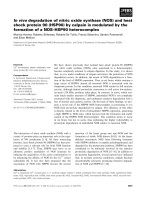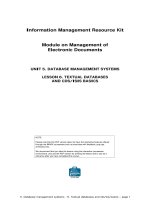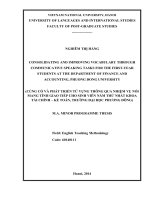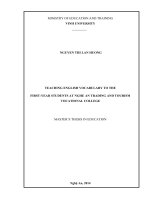Stop, Think, Go, Do: How Typography and Graphic Design Influence Behavior
Bạn đang xem bản rút gọn của tài liệu. Xem và tải ngay bản đầy đủ của tài liệu tại đây (35.23 MB, 225 trang )
STOP
think
GO, DO
STOP
think
GO, DO
HOW TYPOGRAPHY & GRAPHIC DESIGN
INFLUENCE BEHAVIOR
STEVEN HELLER & MIRKO ILIĆ
!
CONTENTS
introduction:
STOP, GO, READ THIS!
Graphic design focuses
our eyes and mind
on what is already
instinctively hardwired.
Play adds dimension
to design, enabling the
viewer to have more
active participation in it.
The language of advocacy
has a common goal: alter
behavior and act upon
instincts, whatever the
outcome may be.
Cautionary messages
force the receiver to
go somewhere or do
something to avoid
dangerous consequences.
INFORM
PLAY
ADVOCATE
CAUTION
13
2 4
chapter
chapter chapter
10–45 77–101
6
47–75 103–127
chapter
?
Much graphic design
cannot afford neutrality;
it must grab attention in
crowded environments.
Graphic design arguably
is itself a grand portal
to the process of
education.
A manifesto should be
a declaration of war
against complacency.
At the very least it should
trigger thinking.
Transformation is not
more than making the
real abstract and vice
versa. It is about taking
something familiar and
making it serendipitous.
ENTERTAIN
EDUCATE
EXPRESS
TRANSFORM
57
6 8
ABOUT THE AUTHORS
ACKNOWLEGMENTS
chapter chapter
chapter
chapter
129–159 199–209
and
224
161–197 211-223
READ THIS
go
Don’t deny it! (See?!) At all times, somewhere, someone is
sending you overt and covert messages, often through media
designed to control your behavior (and now there’s more media
than ever). In the film version of George Orwell’s 1984 (with
Richard Burton in his last role), the ubiquitous “Big Brother is
Watching You” poster makes clear that on- and off-screen, Big
Brother is always present.
This infamous saying was not a benign greeting from a
benevolent “brother,” but an official command to obey—or face
the consequences. It was like all those posters we saw in school,
telling us to do this and not do that—even the ones about staying
healthy were rendered in a threatening tone and ominous style.
Of course, Orwell’s novel was about a fictional totalitarian nation,
Oceania, and a faux omniscient leader, but too many real
governments—past and present—have Big Brothers, or shall we
call them demagogues. This gives credence to the fact that we are
routinely told when, where, and how to behave—for reason-
able and irrational reasons. We accept these dicta virtually
without question.
Now, read on! Or else!
Many of our daily commands are communicated in the forms of
graphic, environmental, and product design. We are conditioned
to respond to the controlling missives we receive, and not
inconsequentially, by the illustrative and typographic appearance
of those missives.
Take the everyday act of crossing the street: It is dictated
by terse commands—stop, go, cross, don’t cross. Alt! Whatever
the language, the orders are always comprehensible in print. If
not the specific words (berhenti means “stop” in Malaysia)—or
the alphabet (Cyrillic or Chinese)—then the colors (e.g., red for
stop, yellow for wait, green for go), symbols (e.g., outstretched
hands for stop), and sign shapes are often unmistakable
HERE’S A FACT OF LIFE:
YOU ARE CONSTANTLY
BEING TOLD WHAT TO DO.
indicators. There is a wide range of forbidden (verbotten),
beware, and scores of iterations of never ever or never again
messages presented to us in picture and word—some of them
are official, others are ad hoc—found everywhere.
Street signs are not the only graphic interventions that
impact our behavioral consciousness and subconsciousness.
Our lives are filled with typographic and pictorial decrees
and warnings designed to either regiment, protect, or otherwise
condition the everyday. So common (even inconsequential)
are some, we often take them for granted—and might even
ignore them entirely (who knows what post no bills actually
means, or employees must wash hands doesn’t apply to me).
Other times they are so jarring (like the unambiguous word
quarantine) we cannot skirt the implication, even if we tried.
Short and lengthily worded commands, proclamations, testi-
monies, and directions have been essential to our hardwired
behavior since signs and symbols were first scratched onto
the Lascaux caves. “Watch Out for Wooly Mammoths!”
Designing commands is not, however, the exclusive province
of graphic designers. In fact, when words are used to influence
behavior, the niceties of typographic design are often sacrificed
for the brutish immediacy of pure, untutored expression.
Of course, typography is essential in getting most messages
across, and designers are responsible, at the very least, for
designing the typefaces, if not also how they are used. It is
unlikely that the word stop would be typeset in a curlicue script
—it just doesn’t have the authority—but anyone, designer
or not, can select a slab serif or bold gothic face to make the
word (or statement) “scream.”
The term scream (or screamer) is, in fact, a jargonistic de-
scription referring to extra-large headlines usually on tabloid
newspapers. It further refers to those words—and images—
that demonstratively influence the receiver or audience.
Designers are well equipped to make the right typographic
decisions to achieve this primal scream. But nondesigners,
and this includes graphic arts and non–graphic arts profes-
sionals, also possess a naive capacity to make fundamental
selections that achieve their goal.
It is a fairly safe bet that if you want someone to take a
message seriously, then you must (emphasis on must) draw
the letters big and bold or select a typeface with those same
characteristics. It doesn’t take a master of fine arts to do it. But
a master of letterforms will do it better than someone who
is merely selecting random alphabets—or so we masters of
letterforms want to believe. When manipulating (or influencing)
behavior of any kind through print, on signs, or on LED screens,
the words carry the “song,” but type and image are the “melody.”
These design elements are hooks that make good lyrics into
great music. This metaphor is apt, because what is music
but a means of altering behavior and triggering emotion?
Design is symphonical, quietly melodical, romantically poetical,
and let’s not forget rousingly oratorical. Type and image, composi-
tion and arrangement, color and hue—choices that designers
make all the time—can make a huge difference in how we
receive the messages and, ultimately, take those persistent orders
from others.
Admittedly, not all design is so demonstrative as to mandate
behavioral submission or acquiescence. Decorative design is
essentially more like wallpaper than a wall poster. Most book
typography is meant to facilitate unhampered reading—it’s not
giving orders. Design is ostensibly a framing mechanism. In
modernist terms, it makes order out of chaos. When design is
operating best, the audience is less aware of the design tropes
than how the design functions. And although we are obviously
conscious of the look of things, the meaning of things is ultimately
more important (well, most of the time).
The book you are about to consume (and enjoy!) is concerned
with that aspect of graphic design that subsumes the look to
the message, although look is of great importance regarding
how the message is telegraphed and received. The genesis for
this book derives from three different well-known design artifacts.
Each, in its own way, demands attention and commands behavior:
1. The stop sign, discussed earlier, is the quintessential
“attention grabber”; only the word Achtung! has
equal force to make us “stop, look, and listen.”
2. “Keep Calm and Carry On,” the 1939 poster produced
by the British Ministry of Information, initially intended
to strengthen morale in the event of a wartime disaster.
The designer is unknown and the poster was never really
used. But it was resurrected recently and reproduced
with a curiously calming effect.
3. “I Want You” is the 1917 James Montgomery Flagg poster
showing Uncle Sam pointing his finger at potential
recruits for World War I. The concept, based on other
iterations in England, Germany, France, and Russia, effec-
tively penetrated the collective psyche with graphic force.
Words and images fused together into a graphic artifact usually
engender Pavlovian responses (show an ice-cold glass of beer
under the word BUD and, if you like such libations, you will
long for the taste). Each of the above examples forces us almost
involuntarily to think and act—stop is a matter of safety; keep
calm is a matter of sanity; and I want you is a matter of
responsibility. We think and act according to our self-interest—
and reflect after it is all over.
When design is operating best, the audience
is less aware of the design tropes than how
the design functions.
stop, think, go, do
8
When Shepard Fairey created his now ubiquitous, genera-
tionally iconic OBEY brand, he was satirizing the power of
design and advertising to demand obedience. Even the most
liberal individual wants obedience from someone.
Of course, there is a range of critical responses to behavioral
design. For this book the topics naturally organize into Inform,
Advocate, Play, Caution, Entertain, Express, Educate, and
Transform. You may (emphasis on may) ask, why these are
the principles of this book. And we will tell you:
INFORM is, informatively, parallel to educate but not exactly the
same. It involves tweaking the audience by bringing to light an
issue, essence, or concern that requires contemplation.
ADVOCATE is, perhaps, the most common of all because designers
are often called upon to create messages that rouse an audience
to support and therefore engage in an issue or event.
PLAY is what every design does, whether knowingly or not. What
is the moving around of word and image but a puzzle or game?
This is the essence of the following sections; through play we
learn, entertain, express, inform, and transform.
CAUTION is, doubtless, the most classic graphic design behavioral
message genre. Keep out, no trespassing, wrong way, beware
of dog, and other cautionary missives are designed to ensure
health and well-being of one and all.
ENTERTAIN is, decidedly, the genre of behavioral design that
everyone enjoys the most. No one is threatened by entertainment,
which has various outcomes but one fundamental goal—to
bring enjoyment.
EXPRESS is, curiously, the largest growth area, for more
designers are using graphically designed words and slogans
as a means of expressing personal beliefs, philosophies, and
manifestoes with the goal of influencing others.
EDUCATE is, in fact, a combination of all the categories here,
except specifically it is the rubric under which more detailed
knowledge messages are shared.
TRANSFORM is an overlapping category whereby projects borne
of play are transformations of what they originally appear to
be. These pieces are sly and wicked, using visual puns and
graphic manipulation to come in under the perception radar.
There are many shared traits between sections, but the
constant throughout the work is playfulness—what Paul Rand
called the “play-principle.” When most effective, play enter-
tains, but also implies the power and process of playing or
experimenting with form and its impact on the audience.
Much of the design works or artifacts in this book are, more
or less, driven by words. Although what we call behavioral
or behavior-influencing design is not all words (sometimes
pictures are indeed worth 1,000 or more words), the major-
ity are not just word based but word and picture integrated.
Some of the typography is simpler—more minimalist—than
others that are elaborate—at times metaphorical. Images play a
defining commanding role too, but only insofar as they are well
integrated with the words and type.
Language is our foremost concern in this book. How the
design language(s) formally and informally interact and inter-
sect with a message in such a way that the audience’s behavior
is altered, the result being a passive or active response—but a
behavioral response nonetheless.
Not all design tells you—or us—what to do or how to feel or
when to think, but much design attempts to get under the skin
and into the mind. This is a survey of some of the most effec-
tive of these over the past five years.
WE WANT YOU TO READ
THIS BOOK! OH YES…NOW!
introduction
9
1
ar •tic•u•late
UNDER
STAND
INSPIRE
Graphic design focuses our eyes and mind on what
is already instinctively hardwired.
INFORM
“Knowledge is power,” Sir Francis Bacon wrote in 1597.
So, to inform an audience through designed messages
is to impart knowledge, which enables self-condfidence
and strength that leads to power. What better way to
influence behavior than to inform. Right? Therefore, this
book begins with a chapter devoted to designing frames
for the presentation of valuable (and not so valuable)
information. This is the broadest of the book’s categories,
since by definition the graphic designer’s single most
important job is to inform.
By processing information the receiver has the ability
to stop, go, think, do—we hope.
Often, however, information is just so much noise, empty
and unnecessary. Or it is propaganda, manipulated and
untrue, but made to be important. Or it is a hawker’s pitch,
the goal of which is to stimulate commercial, political,
or social obedience. Knowledge may be power, but
information is not a priori powerful. And yet whether true
or false, meat or fluff, smart or dumb, when information is
presented in a designed context with the intent of drawing
attention, it is given authority that it either deserves or not.
The designers represented in this section use various
means to present complex information simply or com-
plexly. Some are aesthetically striking, like the poster
series for Ugly Mug Coffee (page 25), which uses discordant
and variegated wood types in a particularly pleasing
typographic composition to present wordy pitches on
the efficacy of drinking java. Some are typographically
dynamic, like the series of event posters for Nouveau
Relax (page 32), which superimposes over photographs
of everyday situations—fish market, subway station,
streetscape—signs announcing art and culture activities.
Environmental super graphics are also a favored way of
informing. The Eureka Tower car park garage (page 38)
11
is a illusionary game, whereby key words—UP, DOWN,
IN, OUT —are rendered at mammoth sizes in primary
colors. But that’s not all; from certain angles they are
read perfectly, yet from others they are distorted to give
the illusion they are posted in air. Another form of envi-
ronmental graphic is not super but it is exceptional: for
POEZIN (page 21), a veritable poster is made out of
colored gaffing tape on a hurricane fence. This one-of-
a-kind “rendering” is photographed for the final piece,
but anyone seeing the original will doubtless be drawn
in by its unconventionality. The POEZIN campaign also
extends to painting information on human bodies and
clothes in such a way as to grab the eye and not let go.
Along the same lines, mixing body art and taping
messages to an environmental surface, the poster campaign
for “Something Raw” for Theateer Frascati in Holland
(page 17), is comprised of bodies and faces evocatively
plastered with the event information using adhesive
materials. The idea for presenting information on the
human body started with tatooing, evolved into the less
permanent sandwich board signs, and then in 1999
Stefan Sagmeister etched information for an AIGA
lecture into his body with a razor blade, the bloody scabs
became the lettering.
Information can be presented in a straightforward
manner, like the poster “Osam Sati Rada, DVA Sata
Pozorista” (page 31), though bold type and neutral graphic
elements. The posters for Take One movie rental service
(page 22), include a bold headline, like “You can have
sex in a theater, but can you cuddle?” against a bright
orange field. Or a more demonstrative typographic
treatment draws attention.
Informing is tricky insofar as it is important not to
overpower the information with conceptual cleverness
or typographic conceit. This is way the advertisements
for Nissan Shift (page 23) using custom street signs to
promote its “free” GPS and air-conditioning is so smart.
The signs, produced in the manner of European street
markers suggest the alternatives to a/c: Heat Road, Humid
Avenue, Sizzle Street, Sweaty Boulevard. In the most
sublime way, these keywords trigger discomfort in the
reader, forcing them to appreciate the value of free air-
conditioning. Sure, many other car companies offer the
same amenity, but this campaign gets under the skin.
Informing is the job of graphic design. Causing the
receiver to act or alter behavior based on that information
is the goal. But turning the information into truly useful
knowledge is icing on the cake.
stop, think, go, do
12
Sensaway Typeface
Designer: Áron Jancsó
Photographer, Illustrator, Typographer: Áron Jancsó
Sensaway is an infinite contrast typeface designed for display
purposes. Dispersing the letterforms in this poster forces the
viewer to focus on the individual shapes.
03 EXCHANGE Atlanta—Braunschweig—Oenbach:
Buchkunst
Client: Klingspor-Museum Oenbach
Designer: Uwe Loesch
Uwe Loesch shifts from abstraction to classic readability with
ease. This poster informs as it delights through its optical
playfulness.
one : inform
13
UNCG Confluence Symposium
Client: Barbara Campbell Thomas
Studio: Typografika
Art Director, Designer, Photographer: Erik Brandt
The layers of information on this poster illustrate the notion of
confluence. The discordant types and bars of color area are both a
mash-up and a logical means of directing the eye.
For a Green and Free Iran
Client: Green Bird/SocialDesignZine
Studio: Typografika
Art Director, Designer, Photographer: Erik Brandt
To commemorate Iran’s Green Party, this
is a joyful layering of information and party
slogan. It engages those who advocate
freedom and entertains those who enjoy a
startling image.
stop, think, go, do
14
June in Močvara, October in Močvara
Client: Club Močvara
Studio: Slobodan Alavanja
Art Director, Creative Director: Slobodan Alavanja
For these posters for programs at Club Močvara, the quilt of type
and color is so aggressive that despite its cluttered appearance,
it demands the viewer to stop and do.
one : inform
15
5 x Berlin
Client: Festival de l’ache de Chaumont
Studio: Fons Hickmann m23
Designers: Fons Hickmann, Markus Büsges, Gesine Grotrian-Steinweg
Photographer: Nina Lüth
The Festival de l’Ache et des Arts in the French city of Chaumont is known
as one of the most important graphic design festivals in all of Europe that
presents a poster art exhibition. The theme in 2006 was Berlin’s design
scene, so Fons Hickmann was invited to design the festival poster, the
accompanying book, and the exhibition.
Should I Stay or Should I Go
Client: m23
Studio: Fons Hickmann m23
Designer: Fons Hickmann
Photographer: Simon Gallus
This announcement for the new website, fonshickmann.com, gives
the facts and nothing but the facts—and a forest of birches, too.
stop, think, go, do
16
Something Raw
Studio: De Designpolitie
Photographer: Arjan
Benning
The body is a de-
pository of so much
information. It is also
a blank slate. This is
a striking canvas on
which so much can
be applied in so many
ways.
one : inform
17
stop, think, go, do
18
Poezin Posters
Client: Poezin
Art Director, Designer, Photographer:
Dragana Nikolić
Photographer (Poezin poster 07 and Poezin
poster 09): Biljana Rakočević
These posters were made for the
poetry event Poezin party (a.k.a. Poetic
clubbing). They were made as a com-
bination of body-painting, handwritten
typography on bodies in dierent poses,
with a certain requisite. This poetry
event includes performance, slam, and all
kinds of engaged contemporary poetry.
one : inform
19
Poetski Bioskop (Poetic Cinema)
Client: Poezin
Art Director, Designer, Photographer: Dragana Nikolić
Three posters for the Poetic Cinema (Poetski Bioskop) were created by transferring
one drawing via video projector on three bodies. Poetic Cinema is a monthly event that
shows projections of short poetic films and videos.
stop, think, go, do
20
Poezin XP
Client: Poezin, Belgrade, Serbia
Art Director, Designer, Photographer: Dragana Nikolić
Posters for the poetry event Poezin XP. This event includes performance,
slam, and all kinds of engaged contemporary poetry. These are two of a
series of open-air design posters done on wire fences all over the city with
tape and felt pens. The surroundings and weather become part of the
posters. And similarly to yellow police line tape, they mark a specific
place—a special zone for poetry.
Design, Money, and …
Client:AIGA Dallas
Studio: Mirko Ilić Corp.
Designers:Mirko Ilić, Eytan Schiowitz
Art Director, Creative Director:Mirko Ilić
Photographer:Matthew Klein
This poster announced a lecture about the
relationship between design, money, and politics.
Because design is in a poor state, everything was
made out of loose change.
one : inform
21
Cell, Cuddle, Date, #2, Pause, Undies
Client: Take One, Video Club
Studio: garcía+robles
Designer, Photographer: Victoralfredo Robles
Art Directors, Creative Directors: Oscar Rodríguez, Victoralfredo Robles
Facts can be communicated in various ways. The clever
quotations, in this otherwise staid campaign for a movie
rental service, hit the nail on the head.
stop, think, go, do
22
Nissan, Heat Road, Humid Avenue, Sizzle Street, Sweaty Boulevard
Client: Nissan
Designer: Igor Miletic
Art Director: Tomislav Jurica Kačunić
Creative Director: Bruketa and Žinić OM/Moe Minkara
Photographer: Tomislav Jurica Kačunić
Copywriter: Daniel Vukovic
Using the street vernacular, in this case street signs, to convey messages
about the Nissan automobile, is a means to inform and entertain.
one : inform
23
Election Campaign: Jack Supports
All Parties, Benevolent Dictatorships,
The Other Kind of Socialist,
Representative from Tennessee,
Champagne, Common Ground
Client: Brown Forman/Jack Daniel’s
Agency: Arnold Worldwide
Designer: Tim Mahoney
Art Directors, Creative Directors: Pete Favat,
Wade Paschall, Wade Devers
Letterpress: Yee-Haw Industries
Copywriters: Gregg Nelson, Craig Johnson,
Lawson Clarke
“Not too long ago, politics were simpler.
Candidates believed in something, they
stood by that belief, and that was that.
And while these days it’s a bit harder
to find a politician with the courage to
stand by their convictions,” say the folks
at Arnold Worldwide, “you know Jack
Daniel’s still does.” With that said, by
combining Jack Daniel’s iconography
and classic ’50s and ’60s American
political design, and with the help of
Yee-Haw Industries Letterpress, Arnold
Worldwide created a series of authentic
campaign posters and ads that got the
Jack Daniel’s message out there. “We
covered the cities hosting the Republi-
can and Democratic national conven-
tions with wild postings, ran full-page
newspaper ads and even set up Jack
Daniel’s Campaign Headquarters, in a
bar of course, for all the thirsty support-
ers. Because if there’s one thing we’ll
need when this is all over, it’s a drink.”
stop, think, go, do
24
Ugly Mug Coee
Client: Ugly Mug Coee
Agency: Young & Laramore
Designer: Yee-Haw Industries
Art Director: Trevor Williams
Creative Director: Charlie Hopper
Copywriter: Bryan Judkins
Photographers: Harold Lee Miller, Gary Sparks
The Ugly Mug campaign is about maintaining high standards,
but taking an unpretentious approach to do so. To give the brand
a feel that communicated both unpretentious and premium
coee, Y&L partnered with traditional letterpress and design
company Yee-Haw Industries. “We felt that the painstaking art
of letterpress was key to creating a signature graphic tone,”
admit the Yee-Haw folks, “first and foremost because letterpress
is both unpretentious and handcrafted. Ugly and beautiful.”
one : inform
25









